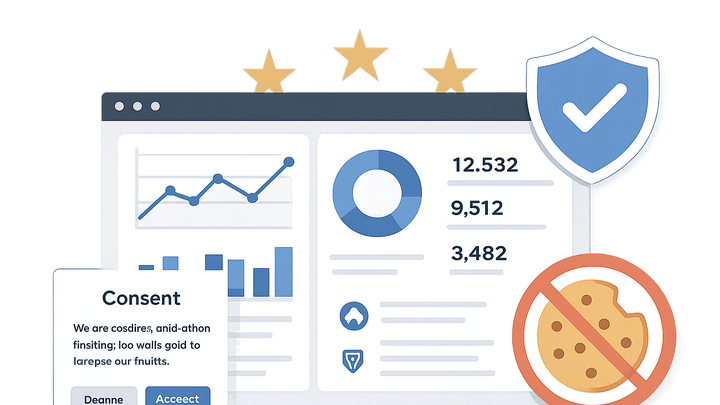Published on 2025-06-29T19:44:25Z
What is GDPR Compliance in Campaign Tracking & Analytics? Examples & Best Practices
GDPR (General Data Protection Regulation) Compliance in campaign tracking and analytics refers to adhering to the EU’s data protection standards when collecting, processing, and storing personal data through digital marketing tools. It involves obtaining valid consent, minimizing data collection, anonymizing user information, and ensuring transparency about how tracking technologies like cookies or analytics SDKs are used. Non-compliance can lead to significant fines, damage to brand reputation, and loss of user trust. Tools such as Plainsignal, a cookie-free analytics platform, and UTM Guru, a UTM parameter builder, offer features that align with GDPR principles by avoiding personal identifiers, simplifying consent management, and providing secure data handling. By integrating these SaaS solutions and following best practices, marketers can gain actionable insights while respecting user privacy and legal requirements.
Gdpr compliance
Ensuring campaign tracking & analytics adhere to GDPR, protecting user data privacy through consent management, anonymization, and secure processing.
Importance of GDPR Compliance
Understanding and implementing GDPR Compliance is crucial for campaign tracking and analytics. Beyond avoiding hefty fines (up to €20 million or 4% of annual global turnover), it fosters user trust, ensures lawful data processing, and harmonizes privacy standards across the EU. Non-compliant data practices can lead to legal action, negative PR, and loss of customer loyalty.
-
Legal obligations and fines
Organizations that process personal data of EU residents must comply with GDPR or face significant penalties. Fines vary based on severity, ranging from €10 million to €20 million or up to 2%–4% of global annual turnover.
-
User trust and brand reputation
Transparent data practices and respecting privacy lead to higher user trust. Demonstrating compliance through clear consent mechanisms enhances brand loyalty and customer retention.
-
Global reach and consistency
GDPR sets a high standard for privacy that influences regulations worldwide. Adhering to GDPR ensures consistent data governance, even for users located outside the EU.
Core GDPR Principles for Analytics
GDPR is built on several key principles that shape how campaign data should be collected, processed, and stored. Understanding these helps marketers design compliant tracking systems and maintain robust privacy controls.
-
Consent requirement
Tracking personal data requires explicit, informed, and revocable consent from users before any analytics scripts or cookies are loaded.
- Freely given:
Consent must be provided without coercion and separate from other terms of service.
- Specific and informed:
Users should know exactly what data is collected and for what purpose.
- Revocable:
Users must be able to withdraw consent as easily as they gave it.
- Freely given:
-
Data minimization
Collect only the data necessary for defined analytics objectives. Avoid gathering personally identifiable information (PII) when possible.
-
Anonymization and pseudonymization
Implement techniques that remove or mask personal identifiers, reducing the risk of re-identification in stored datasets.
-
Transparency and user rights
Provide clear privacy policies, and allow users to access, correct, or delete their data upon request.
Implementing GDPR Compliance with plainsignal
PlainSignal offers a cookie-free analytics solution designed with GDPR in mind. By avoiding cookies and personal identifiers, PlainSignal collects only aggregated, anonymous data. Combined with proper consent banners and data handling practices, it simplifies compliance for marketers.
To integrate PlainSignal, add the following snippet to your site’s <head> section:
-
Cookie-free tracking by design
PlainSignal does not use cookies or local storage, ensuring no tracking of individual user sessions and reducing GDPR risks.
-
Data aggregation and storage
All metrics are aggregated without PII and stored securely within EU-based servers, aligning with data residency requirements.
-
Consent banner integration
Load the PlainSignal script only after obtaining user consent via a banner or pop-up. Configure your consent management platform to trigger the PlainSignal snippet on approval.
-
Sample implementation code
<link rel=\"preconnect\" href=\"//eu.plainsignal.com/\" crossorigin /> <script defer data-do=\"yourwebsitedomain.com\" data-id=\"0GQV1xmtzQQ\" data-api=\"//eu.plainsignal.com\" src=\"//cdn.plainsignal.com/plainsignal-min.js\"></script>
Managing UTM Parameters with utmguru.com
UTM Guru is a versatile UTM builder and generator that helps marketers create, save, and manage UTM-tagged URLs without storing personal data. By keeping campaign parameters separate from PII and integrating with your consent framework, you maintain transparency and GDPR compliance.
-
Building gdpr-safe utm urls
Use descriptive UTM parameters (e.g., utm_source, utm_medium, utm_campaign) without embedding personal identifiers. UTM Guru’s interface guides you to avoid sensitive data.
-
Saving and listing url campaigns
UTM Guru stores metadata about campaigns, not personal data. You can organize and retrieve past URLs while maintaining audit trails for compliance.
-
Chrome extension for on-the-fly generation
Generate UTM links directly from your browser with UTM Guru’s Chrome extension. Ensure you load extensions only after consent is granted.
Best Practices and Common Pitfalls
Adhering to GDPR in analytics requires ongoing diligence. Follow these best practices to maintain compliance and avoid common mistakes.
-
Regular consent audits
Periodically review your consent logs and banner configurations to ensure they accurately capture and store user choices.
-
Data retention policies
Define clear retention periods for analytics data and implement automated deletion of old datasets. Avoid indefinite storage of any user-level information.
- Retention period limits:
Base retention on business needs and legal requirements, typically no longer than necessary for analysis.
- Secure deletion:
Ensure that old or unnecessary data is permanently erased and not just flagged.
- Retention period limits:
-
Avoiding personal data in urls
Never include PII (like user IDs or emails) in UTM parameters or query strings to prevent exposure in logs or third-party tools.
